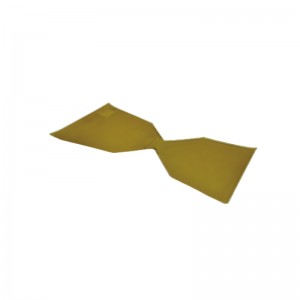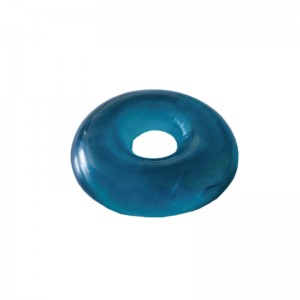
Dome positioner ORP-DP2 (Chest Roll)
Dome Positioner
ORP-DP2
Function
1. Applicable to the prone, supine and lateral position. It can be placed under torso to allow for chest expansion in prone position. It can also be used to support and protect the ankle in prone position and the hip, knee and ankle in supine position.
2. It also can be used in lateral position operation to support and protect armpit.
3. Flat bottom provides stability and keep positioner in place.
| Model | Dimension | Weight |
| ORP-DP2-01 | 32 x 16 x 14cm | 6.2kg |
| ORP-DP2-02 | 41.5 x 15.5 x 14.7cm | 8.3kg |
| ORP-DP2-03 | 52.5 x 16.5 x 14cm | 10.02kg |




Product parameters
Product Name: Positioner
Material: PU Gel
Definition: It is a medical device which is used in an operating room to protect patient from pressure sores during surgery.
Model: Different positioners are used for different surgical positions
Color: Yellow, blue, green. Other colors and sizes can be customized
Product characteristics: Gel is a kind of high molecular material, with good softness, support, shock absorption and compression resistance, good compatibility with human tissues, X-ray transmission, insulation, non-conductive, easy to clean, convenient to disinfect, and does not support bacterial growth.
Function: Avoid pressure ulcer caused by long operation time
Product characteristics
1. The insulation is non-conductive, easy to clean and disinfect. It does not support bacterial growth and has good temperature resistance. The resistance temperature ranges from -10 ℃ to +50 ℃
2. It provides patients with good, comfortable and stable body position fixation. It maximizes the exposure of the surgical field, reduce the operation time, maximize the dispersion of pressure, and reduce the occurrence of pressure ulcer and nerve damage.
Cautions
1. Do not wash the product. If the surface is dirty, wipe the surface with a wet towel. It can also be cleaned with neutral cleaning spray for better effect.
2. After using the product, please clean the surface of the positioners on time to remove dirt, sweat, urine, etc. The fabric can be stored in a dry place after drying in a cool place. After storage, do not put heavy objects on top of the product.
The below information is extracted from AST(Association of Surgical Technologists) Standards of Practice for Surgical Positioning
Standard of Practice III
Based upon the preoperative patient assessment and surgical procedure, the surgical technologist should anticipate the type of OR table and equipment that is needed.
- Surgical personnel should use the positioning equipment according to their designated use and manufacturer’s instructions to avoid injury to the patient.
A. The surgical technologist should verify that the positioning equipment is designed to be used for the specific patient position per surgeon’s orders.
(1) Verification should include the positioning equipment can sustain the weight of the patient. If the manufacturer’s recommendation for weight limitation is exceeded, the positioning equipment should not be used.
(2) The positioning equipment should not be modified to fit he needs of the surgery department, unless the manufacturer has been consulted and approves the modification. The modified positioning equipment should be tested prior to use.
- Positioning equipment, including the OR table and mattresses, should be inspected at least annually by the biomedical engineering technicians to ensure proper functioning in order to contribute to patient safety goals in reducing the risk of intraoperative injuries.
A.The surgery team should test the positioning equipment and OR table prior to use to contribute to the surgery department environment of making patient safety a priority on a daily basis.
- The surgical technologist, in collaboration with the surgical team, should anticipate the type of OR table and positioning equipment necessary.
A. The day before the surgery, the surgical technologist should review the surgery procedures for the OR to anticipate positioning equipment needs and availability.
(1) Reviewing the OR surgery schedule the day before allows the surgical technologist in collaboration with the surgery team to troubleshoot positioning equipment needs, eg equipment is not available due to repairs or shortage of equipment.
B. The choice of OR table and positioning equipment should be based upon the patient’s physiological conditions identified during preoperative assessment, surgeon’s orders, and surgical procedure.
(1) Prior knowledge of a patient’s preexisting condition(s) promotes communication by the surgical team to confirm positioning modifications that satisfies the needs of the team in being able to perform the procedure as well as adjusting to the physiological needs of the patient.
(2) The patient position should provide optimal exposure for placement of IV lines and anesthesia monitoring devices.
(3) Surgical procedure factors, such as surgery site(s), length of procedure, and use of surgical equipment (e.g. imaging equipment, surgical robot, laser) aids in the preoperative determination of where the equipment should be placed based on the patient position.
- On the day of the surgical procedure, the surgical technologist in collaboration with the surgical team should confirm all positioning equipment is available and in the OR, OR table is in working order and positioned according to surgeon’s orders, and surgical equipment and furniture are in the proper position.
- As part of the “time out,” prior to the skin incision, the surgical team should verify the patient position, and all positioning equipment is placed correctly.








